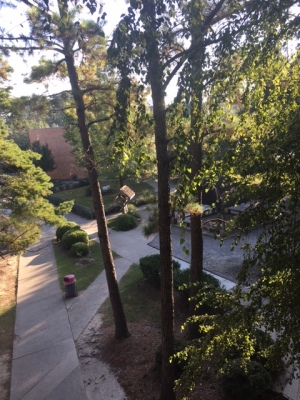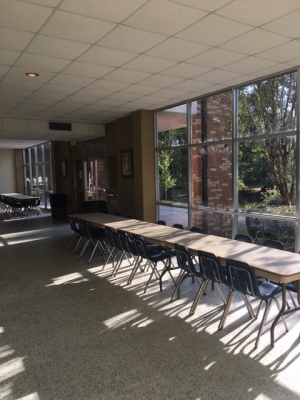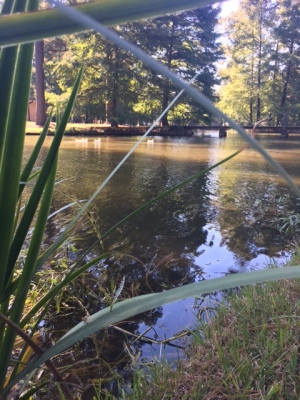
If you arrive on the St. Paul’s campus before 7:10 a.m., a sensation of serenity and history is certain to wash over you.
At this early of an hour, especially during the winter, a shallow cloud of mist eerily hangs over the grass, still peppered with dew.
The only sounds you’ll hear are your own footsteps over the sidewalk pavement; and the only light you’ll see is that emitting from the second floor of Benilde Hall, as the library is the only place a student may take refuge at this hour.
The only students seen will be one or two under the Horack and Bro. Alfred pavilions. Or, maybe, the few sprinkled in the cafeteria, sitting at separate tables gloomily pecking at a single waffle, or link sausage, or whatever the morning cafeteria produces.

As you walk into Benilde Hall, there will not be a stark change in temperature, as the lobby and stairwell’s temperature tend to correlate with that outside. The jagged architecture, inside and out, brings you back to 1963, the year Benilde Hall was completed. When built, Benilde Hall was pioneering in the sense that it served as a transition into the modern architecture movement of the 1960s-70s.
While walking alone up the cracked vinyl stairs, under the minimal light that blankets the walls and floor in a yellow hue, it’s unavoidable to imagine the past generations of students walking with you donning their old St. Paul’s blazers. Upon arriving on the second floor, you’re almost expecting to see a smoking room as you walk the through the glass doors, and step over the threshold into the library.
The ambiance of the library in the morning progresses as a newsroom does when breaking a story. Upon opening, a few unenergetic students generally float in, sit at an unaccompanied table, and produce a few sheets of paper. They proceed to study for whatever class they have first period that day, almost silently. The librarian, contrarily, usually switches from one task to the next frantically, making sure everything is in order for the day to come.
As the time passes, students begin to pour in from every square inch of the school-ground perimeter. The library rudely transforms from a secluded Buddhist monastery to a trading floor in the New York Stock Exchange. Every table is filled, and those who can’t find a seat lean over others. All that is seen is royal blue shirts and sheets of paper being traded, studied, and printed. Sitting in a corner, one can feel the minutes go by faster, then, it’s 7:45, and the tumultuous episode is ceased; blink and you’ll miss it.
At 7:46, it’s as if the campus exhales deeply in relief. While the electric climate of the morning made the trees perk up, the vegetation now reclines in verdant relaxation.

Come 11:12, the students’ and campus’ demeanor rest in a unique state of equilibrium. The energized, anxious attitudes of the students have been dulled by the first two class periods, and the campus air is thick. Under the gaze of the immortalized faces of St. John Baptist de la Salle and the Virgin Mary, students sit in groups in every niche of campus to eat. Banter is prevalent, and the whole student body seems to be engaged in something; it is similar to the morning, but more subdued.
Almost every student passes the chapel if eating at the cafeteria, but few enter. If you were to enter, regardless of your religious belief, the experience would be supernatural. Sit in any pew for a few minutes, and it really does seem as if everything happening the other side of the brick walls is insignificant. Even if there are others present, the feeling of peace and solidarity are unparalleled.
The abhorrent air horn overbears the chimes of the bell tower in calling everyone back to class, and the exhaustion creeps in.
It is often said by students that the hardest thing about third period is staying awake. This mood is felt by every student and teacher on campus. While sitting in class, the cacophonous caw of the crows may very well be the only thing keeping people from drifting into sleep.

The crows of the campus are peculiar in the way that they always flock into the campus directly after lunch. During this dreary 90 minutes, it seems as though they symbolize sleep like they do death in so many instances in literature.
After this period, the school day feels close to its conclusion, and students take their time transitioning to their next class, often stopping under the Wolf Dome for a while or buying a drink.
The last period always flies by, and after Coach Sears utters the last words of the end-of-day prayer, the floodgates of the school’s buildings open, spilling students out by the dozen. Not even 60 seconds will elapse before the first of the car engines can be heard, and before 15 minutes is up, the last of the traffic vanishes.
After school, a few students remain on campus, and again, the only sounds you’ll hear are your own footsteps over the sidewalk pavement.


[…] La) — Roaming the campus of St. Paul’s, it is inevitable that one notices the several monuments that have been erected on campus […]
LikeLike
[…] La) — Roaming the campus of St. Paul’s, it is inevitable that one notices the several monuments that have been erected on campus […]
LikeLike